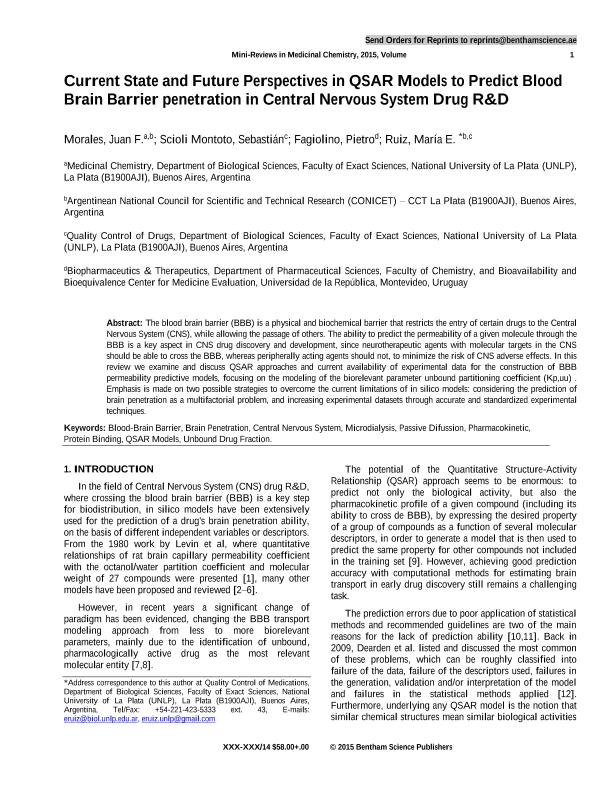Mostrar el registro sencillo del ítem
dc.contributor.author
Morales, Juan Francisco

dc.contributor.author
Scioli Montoto, Sebastián

dc.contributor.author
Fagiolino, Pietro
dc.contributor.author
Ruiz, María Esperanza

dc.date.available
2019-03-28T19:05:00Z
dc.date.issued
2017-02
dc.identifier.citation
Morales, Juan Francisco; Scioli Montoto, Sebastián; Fagiolino, Pietro; Ruiz, María Esperanza; Current state and future perspectives in QSAR models to predict blood-brain barrier penetration in central nervous system drug R&D; Bentham Science Publishers; Mini-reviews In Medicinal Chemistry; 17; 3; 2-2017; 247-257
dc.identifier.issn
1389-5575
dc.identifier.uri
http://hdl.handle.net/11336/72761
dc.description.abstract
The Blood-Brain Barrier (BBB) is a physical and biochemical barrier that restricts the entry of certain drugs to the Central Nervous System (CNS), while allowing the passage of others. The ability to predict the permeability of a given molecule through the BBB is a key aspect in CNS drug discovery and development, since neurotherapeutic agents with molecular targets in the CNS should be able to cross the BBB, whereas peripherally acting agents should not, to minimize the risk of CNS adverse effects. In this review we examine and discuss QSAR approaches and current availability of experimental data for the construction of BBB permeability predictive models, focusing on the modeling of the biorelevant parameter unbound partitioning coefficient (Kp,uu). Emphasis is made on two possible strategies to overcome the current limitations of in silico models: considering the prediction of brain penetration as a multifactorial problem, and increasing experimental datasets through accurate and standardized experimental techniques.
dc.format
application/pdf
dc.language.iso
eng
dc.publisher
Bentham Science Publishers

dc.rights
info:eu-repo/semantics/openAccess
dc.rights.uri
https://creativecommons.org/licenses/by-nc-sa/2.5/ar/
dc.subject
Blood-Brain Barrier
dc.subject
Brain Penetration
dc.subject
Central Nervous System
dc.subject
In Silico Models
dc.subject
Microdialysis
dc.subject
Passive Difussion
dc.subject
Pharmacokinetic
dc.subject
Protein Binding
dc.subject
Qsar Models
dc.subject
Unbound Drug Fraction
dc.subject.classification
Medicina Química

dc.subject.classification
Medicina Básica

dc.subject.classification
CIENCIAS MÉDICAS Y DE LA SALUD

dc.title
Current state and future perspectives in QSAR models to predict blood-brain barrier penetration in central nervous system drug R&D
dc.type
info:eu-repo/semantics/article
dc.type
info:ar-repo/semantics/artículo
dc.type
info:eu-repo/semantics/publishedVersion
dc.date.updated
2019-03-15T18:24:03Z
dc.journal.volume
17
dc.journal.number
3
dc.journal.pagination
247-257
dc.journal.pais
Estados Unidos

dc.journal.ciudad
Oak Park
dc.description.fil
Fil: Morales, Juan Francisco. Consejo Nacional de Investigaciones Científicas y Técnicas; Argentina. Universidad Nacional de La Plata. Facultad de Ciencias Exactas; Argentina
dc.description.fil
Fil: Scioli Montoto, Sebastián. Universidad Nacional de La Plata. Facultad de Ciencias Exactas; Argentina
dc.description.fil
Fil: Fagiolino, Pietro. Universidad de la República; Uruguay
dc.description.fil
Fil: Ruiz, María Esperanza. Consejo Nacional de Investigaciones Científicas y Técnicas; Argentina. Universidad Nacional de La Plata. Facultad de Ciencias Exactas; Argentina
dc.journal.title
Mini-reviews In Medicinal Chemistry

dc.relation.alternativeid
info:eu-repo/semantics/altIdentifier/doi/http://dx.doi.org/10.2174/1389557516666161013110813
dc.relation.alternativeid
info:eu-repo/semantics/altIdentifier/url/http://www.eurekaselect.com/146235/article
Archivos asociados
